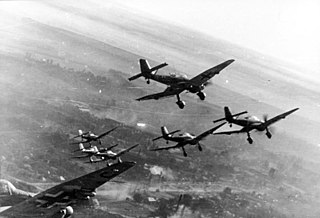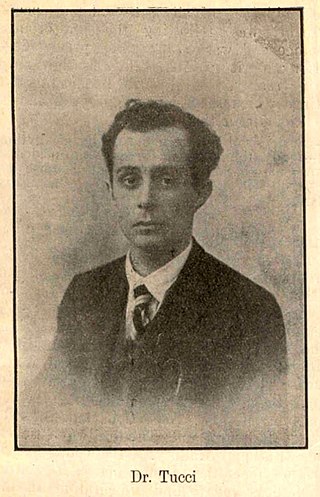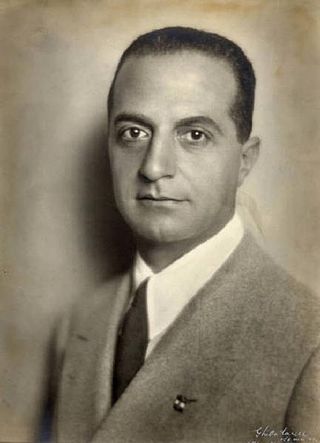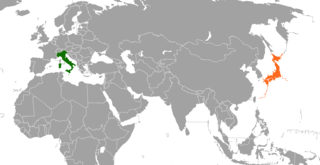Related Research Articles

World War II or the Second World War was a global conflict that lasted from 1939 to 1945. The vast majority of the world's countries, including all the great powers, fought as part of two opposing military alliances: the Allies and the Axis. Many participating countries invested all available economic, industrial, and scientific capabilities into this total war, blurring the distinction between civilian and military resources. Aircraft played a major role, enabling the strategic bombing of population centres and delivery of the only two nuclear weapons ever used in war. It was by far the deadliest conflict in history, resulting in 70–85 million fatalities. Millions died due to genocides, including the Holocaust, as well as starvation, massacres, and disease. In the wake of Axis defeat, Germany, Austria, and Japan were occupied, and war crime tribunals were conducted against German and Japanese leaders.

The Axis powers, originally called the Rome–Berlin Axis and also Rome–Berlin–Tokyo Axis, was a military coalition that initiated World War II and fought against the Allies. Its principal members were Nazi Germany, the Kingdom of Italy and the Empire of Japan. The Axis were united in their far-right positions and general opposition to the Allies, but otherwise lacked comparable coordination and ideological cohesion.

The Tripartite Pact, also known as the Berlin Pact, was an agreement between Germany, Italy, and Japan signed in Berlin on 27 September 1940 by, respectively, Joachim von Ribbentrop, Galeazzo Ciano, and Saburō Kurusu and in the presence of Adolf Hitler. It was a defensive military alliance that was eventually joined by Hungary, Romania, Bulgaria, and Yugoslavia as well as by the German client state of Slovakia. Yugoslavia's accession provoked a coup d'état in Belgrade two days later. Germany, Italy, and Hungary responded by invading Yugoslavia. The resulting Italo-German client state, known as the Independent State of Croatia, joined the pact on 15 June 1941.

The Pact of Steel, formally known as the Pact of Friendship and Alliance between Germany and Italy was a military and political alliance between Italy and Germany.

The Anti-Comintern Pact, officially the Agreement against the Communist International was an anti-Communist pact concluded between Nazi Germany and the Empire of Japan on 25 November 1936 and was directed against the Communist International (Comintern). It was signed by German ambassador-at-large Joachim von Ribbentrop and Japanese ambassador to Germany Kintomo Mushanokōji. Italy joined in 1937, but it was legally recognised as an original signatory by the terms of its entry. Spain and Hungary joined in 1939. Other countries joined during World War II.

Yōsuke Matsuoka was a Japanese diplomat and Minister of Foreign Affairs of the Empire of Japan during the early stages of World War II. He is best known for his defiant speech at the League of Nations in February 1933, ending Japan's participation in the organization. He was also one of the architects of the Tripartite Pact and the Soviet–Japanese Neutrality Pact in the years immediately prior to the outbreak of war.

Giuseppe Tucci was an Italian orientalist, Indologist and scholar of East Asian studies, specializing in Tibetan culture and the history of Buddhism. During its zenith, Tucci was a supporter of Italian fascism, and he used idealized portrayals of Asian traditions to support Italian ideological campaigns. Tucci was fluent in several European languages, Sanskrit, Bengali, Pali, Prakrit, Chinese and Tibetan and he taught at the University of Rome La Sapienza until his death. He is considered one of the founders of the field of Buddhist Studies.

Giuseppe Bottai was an Italian journalist and member of the National Fascist Party of Benito Mussolini.

Germany–Japan relations were officially established in 1861 with the first ambassadorial visit to Japan from Prussia. Japan modernized rapidly after the Meiji Restoration of 1868, often using German models through intense intellectual and cultural exchange. After Japan aligned itself with Britain in 1900, Germany and Japan became enemies in World War I. Japan declared war on the German Empire in 1914 and seized key German possessions in China and the Pacific.

The National Legionary State was a totalitarian fascist regime which governed Romania for five months, from 14 September 1940 until its official dissolution on 14 February 1941. The regime was led by General Ion Antonescu in partnership with the Iron Guard, the Romanian ultra-nationalist, and anti-communist organization. Though the Iron Guard had been in the Romanian Government since 28 June 1940, on 14 September it achieved dominance, leading to the proclamation of the National Legionary State.

The Axis leaders of World War II were important political and military figures during World War II. The Axis was established with the signing of the Tripartite Pact in 1940 and pursued a strongly militarist and nationalist ideology; with a policy of anti-communism. During the early phase of the war, puppet governments were established in their occupied nations. When the war ended, many of them faced trial for war crimes. The chief leaders were Adolf Hitler of Nazi Germany, Benito Mussolini of Fascist Italy, and Hirohito of Imperial Japan. Unlike what happened with the Allies, there was never a joint meeting of the main Axis heads of government, although Mussolini and Hitler met on a regular basis.

Massimo Bontempelli was an Italian poet, playwright, novelist and composer. He was influential in developing and promoting the literary style known as magical realism.
Tōyō Mitsunobu was a captain of the Imperial Japanese Navy. Mitunobu worked in the Japanese naval command in China.

Camillo Pilotto was an Italian film actor. He appeared in 101 films between 1916 and 1963. He was born and died in Rome, Italy.

Italy–Japan relations are the bilateral relations between the Italian Republic and Japan.
On December 11, 1941, Italy declared war on the United States in response to the latter's declaration of war upon the Empire of Japan following the attack on Pearl Harbor four days earlier. Germany also declared war on the U.S. the same day. The US immediately responded by declaring war on Germany and Italy, thus thrusting the United States in fighting two major fronts across the Pacific and Atlantic Oceans in World War II.

La Difesa della Razza was a Fascist magazine which was published in Rome between 1938 and 1943 during the Fascist rule in Italy. Its subtitle was Scienza, Documentazione, Polemica. It played a significant role in the implementation of the racial ideology following the invasion of Ethiopia and the introduction of the racial laws in 1938.
Giuseppe Gorla (1895–1979) was an Italian civil engineer and politician who was a member of the National Fascist Party. Between 1940 and 1943 he served as the minister of public works.
Italien was a monthly far-right cultural magazine published in Heidelberg between 1927 and 1944 with two-year interruption to reinforce the relations between Germany and the fascist rule in Italy. Its subtitle was Monatsschrift für Kultur, Kunst und Literatur.
References
- ↑ Daniel Hedinger (2017). "The Spectacle of Global Fascism: The Italian Blackshirt mission to Japan's Asian empire". Modern Asian Studies . 51 (6): 1999–2034. doi:10.1017/S0026749X17000026.
- ↑ Nadin Heé (2019). "Tuna as an Economic Resource and Symbolic Capital in Japan's "Imperialism of the Sea"". In Rotem Kowner; et al. (eds.). Animals and Human Society in Asia. Historical, Cultural and Ethical Perspectives. Cham: Palgrave Macmillan. p. 238. ISBN 978-3-030-24362-3.
- 1 2 3 4 5 6 Sergio Raimondo; Valentina De Fortuna; Giulia Ceccarelli (July–December 2017). "Bushido as allied: The Japanese warrior in the cultural production of Fascist Italy (1940-1943)". Revista de Artes Marciales Asiáticas. 12 (2): 89. doi: 10.18002/rama.v12i2.5157 .
- 1 2 Christian Goeschel (2022). "Performing the New Order: The Tripartite Pact, 1940–1945". Contemporary European History: 14. doi: 10.1017/S0960777322000340 .